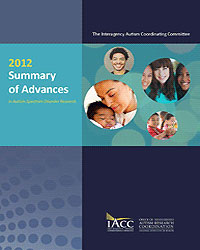Summary of Advances
In Autism Spectrum Disorder Research
2012
Occurrence and family impact of elopement in children with autism spectrum disorders – Anderson C, Law JK, Daniels A, Rice C, Mandell DS, Hagopian L, Law PA. Pediatrics. 2012 Nov;130(5):870-7. [PMID: 23045563]
Anecdotal accounts have suggested that elopement, or wandering, behavior is common in children with ASD, but little research had been done to characterize this behavior or to determine its frequency. This study used the Interactive Autism Network (IAN), an online research database and autism registry supported by Autism Speaks, the Simons Foundation, and the National Institute of Mental Health, to conduct a survey of families to determine the extent to which children with ASD wander away from a supervised, safe place or from the care of a responsible person. Families enrolled in IAN that had a child with ASD who was between 4 and 17 years old were invited to participate in the survey of wandering behavior, which was developed by ASD researchers, clinicians, and parent advocates. Of the 1,218 children with ASD and their 1,076 siblings without ASD included in the study, nearly half (49%) of the children with ASD had attempted to wander at least once since the age of 4, compared to only 13% of their siblings without ASD. Wandering behavior was more common among children with greater autism severity. Most frequently, the children wandered from home or school settings, or while on shopping trips with their families. Twenty-six percent of the families with children with ASD reported at least one instance when their child was missing long enough to cause concern. Children were missing for an average of 41.5 minutes and many faced close calls with traffic injury (65%) or drowning (24%) during this time. Parents and caregivers reported multiple potential motivations for their child's wandering, including the desire to explore, trying to find a place that they enjoy, escaping an anxious situation, and escaping uncomfortable sensory stimuli. Wandering behavior also had a large impact on the families of children with ASD, including disrupted sleep, avoidance or lack of enjoyment in activities outside of the home, and increased levels of stress. Fifty percent of families reported that they had not received any guidance on how to prevent or address wandering behaviors, and future research is needed to identify the best ways to support these families. This initial characterization and documentation of wandering behavior in children with ASD provides a foundation for additional research on wandering to further define this behavior and develop effective prevention and intervention strategies.
Excess mortality and causes of death in autism spectrum disorders: A follow up of the 1980s Utah/UCLA Autism Epidemiologic Study – Bilder D, Botts EL, Smith KR, Pimentel R, Farley M, Viskochil J, McMahon WM, Block H, Ritvo E, Ritvo RA, Coon H. J Autism Dev Disord. 2012 Sep 25. [Epub ahead of print] [PMID: 23008058]
Although previous studies have reported increased mortality rates for people with ASD, there has been limited knowledge regarding the causes of death and whether certain subpopulations may be at higher risk. Using data from a study in Utah from the 1980s that assessed the statewide prevalence of autism, a group of researchers examined the records of the original study population three decades later to evaluate the long-term rates and causes of mortality among individuals diagnosed with ASD. This follow-up study included 305 individuals who were either diagnosed with ASD during the initial study (using the Diagnostic and Statistical Manual of Mental Disorders (DSM)-III) or through re-evaluation and reclassification based on more recent diagnostic criteria (DSM IV-TR). By the end of 2011, 29 of the 305 individuals (9.5%) had died. Thus, the hazard rate ratio for individuals with ASD compared to those without ASD was 9.9, meaning that an individual with ASD was 9.9 times more likely to have died over a certain time period than someone in the general population. These hazard rate ratios decreased slightly when family members (cousins or siblings) without ASD were used as controls, indicating that familial factors, either environmental or genetic, may also contribute to mortality. Overall, the hazard rate ratio of 9.9 in this study is higher than any previous studies, in which hazard rate ratios for individuals with ASD ranged from 0 to 5.6. The main causes of death for individuals in this study, obtained from death certificates, were respiratory, cardiac, and epileptic events, and the mortality rate increased with the severity of intellectual disability. Relatively few deaths were due to unnatural causes such as accidents or suicide. The general association of increased mortality risk with the presence of co-occurring conditions and intellectual disability, rather than with ASD itself, highlights the importance of coordinated medical care for those individuals with ASD who have multiple co-occurring medical issues in addition to the classic symptoms associated with ASD.




